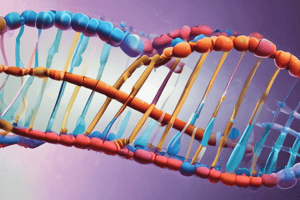Podcast
Questions and Answers
What is the function of helicase?
What is the function of helicase?
- Unwinds part of DNA helix (correct)
- Synthesizes RNA primers
- Cleanses DNA fragments
- Replicates DNA
What does DNA Polymerase I do?
What does DNA Polymerase I do?
It participates in prokaryotic DNA replication.
What is a lagging strand?
What is a lagging strand?
A DNA strand that undergoes replication discontinuously in small fragments.
What is the leading strand?
What is the leading strand?
What does ligase do?
What does ligase do?
What is a nuclease?
What is a nuclease?
What are Okazaki fragments?
What are Okazaki fragments?
What are origins of replication?
What are origins of replication?
What is primase?
What is primase?
What is a primer?
What is a primer?
What is a replication bubble?
What is a replication bubble?
What is a replication fork?
What is a replication fork?
What do single-strand binding proteins do?
What do single-strand binding proteins do?
What are telomeres?
What are telomeres?
What does antiparallel mean in DNA?
What does antiparallel mean in DNA?
What is replication?
What is replication?
Flashcards are hidden until you start studying
Study Notes
Helicase
- Unwinds DNA helix structure, facilitating replication.
- Stabilized by single-stranded binding proteins to prevent re-annealing.
DNA Polymerase I
- Enzyme involved in prokaryotic DNA replication.
- Plays a key role in the repair and primer removal during replication processes.
DNA Polymerase III
- Primary enzyme complex for prokaryotic DNA replication.
- Discovered in 1970 by Thomas Kornberg and Malcolm Gefter.
- Part of the replisome at the replication fork, essential for synthesizing new DNA strands.
Lagging Strand
- One of the two DNA strands at the replication fork.
- Replicates discontinuously in small fragments known as Okazaki fragments, creating a slight delay.
Leading Strand
- The other DNA strand at the replication fork.
- Replicated continuously in the 3' to 5' direction as replication progresses.
Ligase
- Enzyme responsible for joining DNA fragments together.
- Essential for sealing nicks and creating a continuous DNA strand.
Nuclease
- Enzyme that cleaves nucleotides in nucleic acids.
- Helps in processing and editing DNA during replication and repair.
Okazaki Fragments
- Short DNA segments synthesized on the lagging template strand.
- Complementary to the lagging strand, forming double-stranded sections of DNA.
Origins of Replication
- Specific locations where DNA replication initiates and the separation of parent strands occurs.
Primase
- Enzyme that synthesizes short RNA primers crucial for DNA replication.
- Provides a starting point for DNA synthesis, as DNA polymerases can only add nucleotides to an existing strand.
Primer
- Short strand of RNA or DNA, usually 18-22 bases long.
- Serves as the starting point for DNA synthesis, necessary for the action of DNA polymerases.
Replication Bubble
- Formation created when DNA strands separate during replication.
- Allows access to the DNA template for replication machinery.
Replication Fork
- Structure formed during DNA replication where the double helix is unwound.
- Leading strand is synthesized continuously in the direction of the fork’s movement.
Single-Strand Binding Proteins
- Proteins that stabilize single-stranded DNA during replication.
- Prevent re-annealing and protect the DNA from degradation.
Telomeres
- Compound structures located at the ends of chromosomes.
- Protect genetic data and play a role in cellular aging and division.
Antiparallel
- Refers to the orientation of the two DNA strands in opposite directions.
- Essential for the proper base pairing and replication processes.
Replication
- Process through which DNA is copied to generate new cells.
- Occurs during the interphase of the cell cycle, producing daughter DNA strands.
Studying That Suits You
Use AI to generate personalized quizzes and flashcards to suit your learning preferences.




